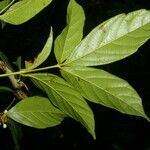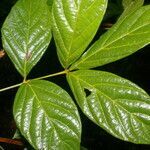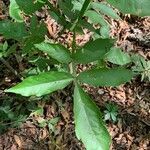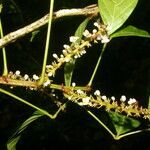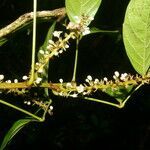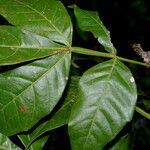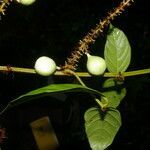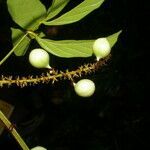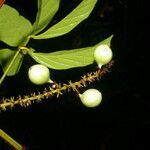Lianas; older stems 3-ribbed, the younger ones mostly 6-ribbed, glabrous to puberulous; wood composite; tendrils forked. Leaves pinnately 5-foliolate, strigillose on the upper side of the petiole, rachis, and midrib; petiole to 8 cm long; petiole and rachis winged, their margins ciliate; leaflets elliptic, short-acuminate, obtuse at the base, 5-11 cm long, 2.5-4.5 cm wide, with granular punctations throughout on both surfaces and with tufted vein axils beneath, conspicuously crenate throughout most of the margin, the teeth glandular; stipules lanceolate, densely appressed-pubescent, less than 10 mm long, deciduous. Thyrses solitary, 5-25 cm long, axillary or borne at forks of tendrils, spikelike. Flowers white or yellowish, ca. 3 mm wide, wider than long; bracteoles linear-lanceolate, 2.5-4.5 mm long, appressed-pubescent on both surfaces; sepals equal, 5, appressed-pubescent; petals narrowly obovate, 2.5-3 mm long, the anterior scales obovate, fused about half their length to the petal, villous, the deflexed appendage and its villous margin extending more than halfway to the base of the scale, the crest obovate, orange; staminate flowers with the stamens exserted, ca. 2.5-3 mm long, filaments flattened, villous, the pistil short, 3-sided, villous at the apex, the styles glabrous, equalling the ovary; bisexual flowers with the stamens to 2.5 mm long, the ovary ovoid, densely appressed-pubescent to nearly glabrous, the ovary and style together ca. 4 mm long, the style about as long as the ovary, glabrous, 3-branched in the upper third. Capsules broadly clavate, 2-4 cm long, rounded to truncate and abruptly acuminate at the apex, gradually tapered to a long-stipitate base, red, 3-celled, round to bluntly 3-sided in cross-section; seeds 1-3, ellipsoid, 1.5-3 cm long, black, shiny, partly enclosed by a white aril.
Woody vine 5-15 m long, usually many-branched from base. Stems obtusely 3-5-angled, glabrous or pubescent, glabrous when mature, to 6 cm in diameter, producing scarce milky latex; cross section with a central vascular cylinder and 2 or 3 peripheral smaller vascular cylinders. Stipules subulate, ca. 5 mm long. Leaves pinnately 5-foliolate; petiole and rachis winged; petiolules 3-4 mm long; leaflets coriaceous, elliptical, ovate or lanceolate, 5-16 × 2.2-6 cm (the distal leaflet larger), the apex acute, the base attenuate or acute on distal leaflet, obtuse or rounded, sometimes asymmetrical on lateral ones, the margins deeply serrate-dentate; adaxially glabrous or puberulent along the midvein, green, shiny, with slightly prominent venation; abaxially glabrous or puberulent along the midvein, green, dull, the venation prominent, with a tuft of hairs in the axils of the secondary veins, tertiary venation reticulate. Thyrses axillary, racemiform, solitary; axis tomentose; cincinni sessile, few-flowered. Calyx light green, puberulent, of 5 sepals, outer sepals ca. 2 mm long, inner sepals 4-5 mm long; petals white, obovate, 4-5 mm long; appendages slightly shorter than the petals, with fleshy, yellow crest; nectary of 4 rounded to ovoid lobes. Capsule pyriform to club-shaped, unwinged, long-stipitate, red, coriaceous, glabrous, 1.5-3 cm long, 1-3-seeded; mesocarp ca. 0.5 mm thick; endocarp glabrous. Seed usually one per fruit, 12-15 mm long, ellipsoid, with white sarcotesta except at the black apex.
A woody creeper or vine. It can be 5-10 m long. The leaves have 5 leaflets. The leaf stalk has wings. The flower racemes occur singly in the axils of leaves. They can be 10 cm long. The flower are in clusters without stalks. The flowers are white. The fruit is an oblong or pear shaped capsule. It is 3 cm long by 1.4 cm wide. It is pinkish red and has fine lines along it. The valves are woody and there is 1 or sometimes 3 seeds inside. These are 1 cm long by 0.8 cm wide and 0.6 cm thick. They are shiny and blue-purple to black. There is a white aril or layer around the seed. This is edible.
Leaves up to 30 cm. long (usually c. 12 cm.); stipules 4–5 × 1–1·5 mm., narrowly triangular, pubescent; petiole up to 10 cm. long, winged, pubescent; rhachis with wing up to 8 mm. broad; petiolules 1–3 mm. long, pubescent; leaflet-lamina up to 16 × 9 cm., ovate or elliptic or obovate, pubescent or pilose on the nerves but otherwise nearly glabrous, apex usually acuminate, margin dentate to subentire, base cuneate; lateral nerves 7–9 pairs.
Inflorescence an axillary paniculate thyrse, floriferous portion usually c. 5 cm. long, tendrils c. 2 cm. long when coiled (sometimes absent); peduncle up to 11 cm. long (occasionally very short), minutely pubescent.
Ovary 3-gonous, shortly stipitate, appressed-pubescent; style 3 mm. long; pistillode 1 mm. long in male flowers.
Petals 4 × 2 mm., narrowly obovate, unguiculate, with a large ciliate scale attached to the claw.
Fruit up to 28 × 12 mm., narrowly obconic, 3-gonous, apiculate, shortly stipitate, glabrous.
Sepals 1·5–3 mm. long, the larger ones elliptic, the smaller ones subcircular.
Stamens unequal; filaments 2–4 mm. long, pilose.
Liane or scandent shrub; branchlets pubescent.
Scarlet capsular more or less 3-angled fruit
Flowers white; pedicels up to 4 mm. long.
A woody or subwoody climber with tendrils
Seed blackish, 12–15 × 6–8 mm.
Small white flowers
